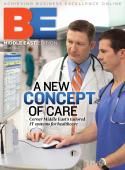The healthy optionThe Sisters of Mercy Health System is staying true to the principles of its founders by adopting 21st-century management and delivery approaches, Ruari McCallion learns. The Sisters of Mercy were founded in Ireland at the turn of the 19th century by Catherine McAuley, a young woman who inherited a fortune from her adoptive parents and put it to work rendering support, shelter, care and education to the poor and disadvantaged of Dublin. The Sisters of Mercy Health System (SMHS), based in St. Louis, has remained faithful to her calling to the ÔÇ£healing ministryÔÇØÔÇöa phrase that crops up in its public communications and in conversationÔÇöbut she would probably be surprised to learn that SMHS recently won an award for supply chain management from the US Council of Supply Chain Management Professionals, especially since it beat leading organizations from industry and manufacturing, for whom supply chain optimization has become second nature. ÔÇ£Resource Optimization and Innovation (ROI) was created by SMHS to establish the supply chain as a strategic imperative for the business,ÔÇØ says Hector Boirie, chief capital management officer. ÔÇ£We have two other divisions dedicated to supporting SMHS: Mercy Information Services, which manages our IT, and Capital Management.ÔÇØSMHS has eight Strategic Service Units (SSUs) in 20 cities across the states of Missouri, Arkansas, Kansas, Oklahoma, Louisiana and Texas. They provide healthcare through 28 individual locations, as well as integrated physician, long-term residential care and other services, which range from full hospital complexes, such as St. JohnÔÇÖs Mercy Hospital in Washington, Missouri, through to the assisted living facility at The Gardens at Osage Terrace in Bentonville, Arkansas.ÔÇ£We provide acute care and direct in-patient care within our hospitals and clinics, and we also have outreach ministries in Laredo, Texas, in Louisiana, and in Mississippi,ÔÇØ says Boirie. ÔÇ£WeÔÇÖre heavily integrated with physicians and have dozens of primary healthcare centers and hundreds of physician centers over those areas. SMHS is the ninth-largest Catholic healthcare system in the US, based on net patient service revenue, and in the top 20 of all healthcare providers across the country.ÔÇØ SMHS recently opened a brand new replacement hospital at Rogers, Arkansas, which is designed to expand the capabilities of the old facilities in the city. The capital value of current projects amounts to $400ÔÇô500 million, from planning to construction and occupation, and includes replacement patient towers in St. Louis and Springfield, Missouri, and in Ardmore, Oklahoma, and a new heart hospital and neonatal unit in Oklahoma City. Its ambitious expansion and renewal plans are challenged by the rises in commodity and materials costs, but it is doing something about all of it.ÔÇ£We partner with designers and contractors from early in the project and draw on their expertise,ÔÇØ Boirie says. ÔÇ£By the time weÔÇÖre ready to build, weÔÇÖve hopefully drawn all possible advantages and are able to build as lean as we can. We can then deal with the real cost, which enables us to analyze whether a project makes business sense in the current economic climate. We canÔÇÖt stop growth completely, though some projects are being slowed and some delayed. Mercy works because we have the benefit of size, which allows us to invest in mission-driven, community-based projects. We keep a close eye on our debt-to-cash ratio; we have multi-year capital programs and place specific expectations of operations on the different SSU teams. If part of the organization isnÔÇÖt performing financially, the planned capital investment may be reallocated.ÔÇØSMHS puts lean principles into practice not only through control and elimination of waste but also through standardization of work, wherever that is possible. Reducing variations reduces expense; it uses a simple formula to justify operations, capital management, return on investment and so on. Best practices are shared among all operations, something the ROI department is particularly useful for. The team has worked with General Electric to apply six sigma and with Wal-MartÔÇöwhich is headquartered in Bentonville, where SMHS has a hospitalÔÇöon examining payback on different ideas. One area that has attracted especial attention is energy costs, which are a long-term, lifecycle expense.ÔÇ£We started by looking at LEED, but we decided that was too limiting,ÔÇØ says Jason Popelka, corporate architect. ÔÇ£It didnÔÇÖt have the operations and management component we found with GGHC [Green Guide for Health Care]. We modified GGHC to develop the Mercy Green Points system, which provides guidance to all projects. It covers water conservation, construction materials, use of recycled materials, site sustainability and environmental practices. The Wal-Mart team is undertaking an environmental audit at our old hospital, St. MaryÔÇÖs, in Rogers, Arkansas, and weÔÇÖre looking at various ideas to suggest to the next owners to help them reduce their carbon footprint.ÔÇØ SMHS has adopted retro-commissioning, which involves sending in teams to fine-tune facilities and improve their energy performance and water usage. It is in the process of replacing water-cooled equipment with closed-loop coils; it recycles aluminum, glass and metal, and has seen disposal cost turn into a revenue stream. It selects plants that are indigenous to local areas so they need less watering.ÔÇ£We look through the whole system, one point at a time, and ask what the impact is. A team led by Melissa Russo is looking at ways of adding heat recycling and recapture for heating water and space,ÔÇØ says Terry Bader, executive director of planning, design and construction. ÔÇ£It may add initial cost, but we look at the annualized return on investment. If it has, say, a seven-year payback, then the return is 14 percent. Looked at in that light, itÔÇÖs a better return than the bond market. While we donÔÇÖt expect anything to get cheaper, we look to control our costs to maintain competitiveness. If the team can provide better-quality healthcare within the same kind of budget as competitors, then people will come here. WeÔÇÖre working to improve throughput and quality as core to our caring ministry mission and values. Effective operations, which include advanced facility design, flexibility to achieve peak savings and increased throughput, all increase the effectiveness of Sisters of Mercy Health System.ÔÇØ┬á









